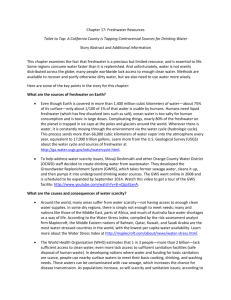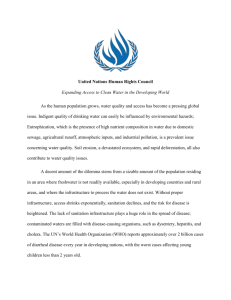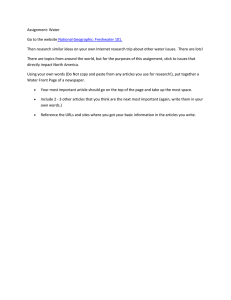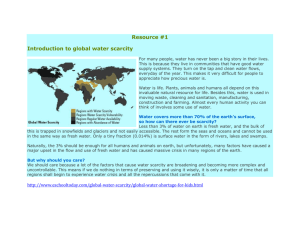Freshwater and Human Population: A Global Perspective
advertisement
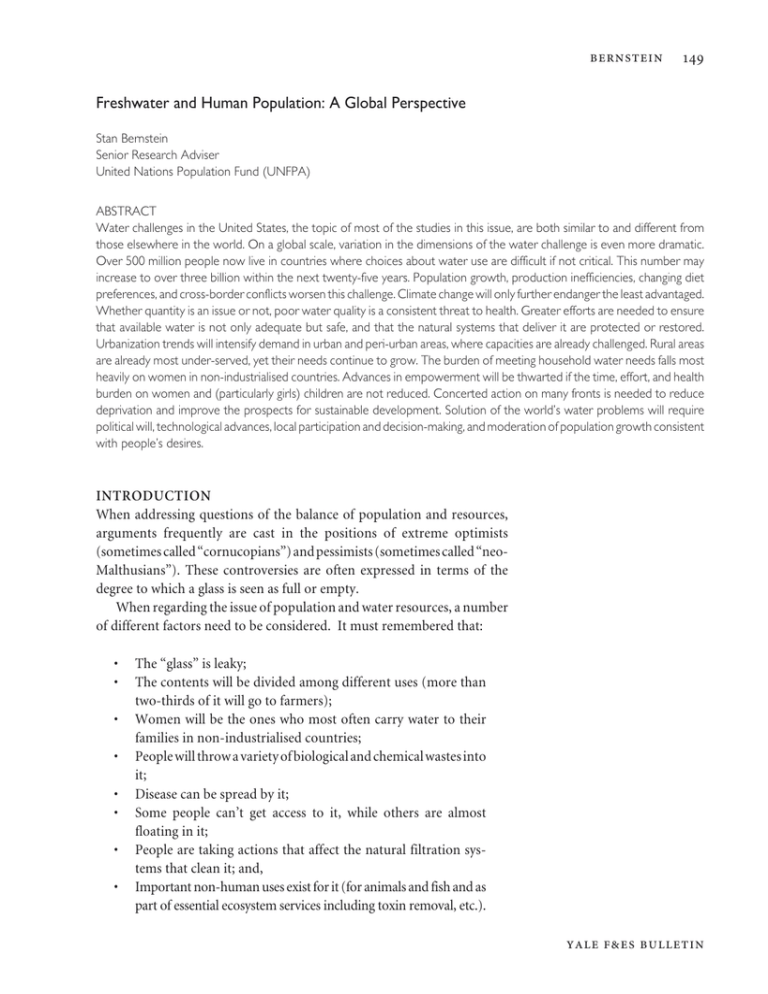
Freshwater and Human Population: A Global Perspective Stan Bernstein Senior Research Adviser United Nations Population Fund (UNFPA) ABSTRACT Water challenges in the United States, the topic of most of the studies in this issue, are both similar to and different from those elsewhere in the world. On a global scale, variation in the dimensions of the water challenge is even more dramatic. Over 500 million people now live in countries where choices about water use are difficult if not critical. This number may increase to over three billion within the next twenty-five years. Population growth, production inefficiencies, changing diet preferences, and cross-border conflicts worsen this challenge. Climate change will only further endanger the least advantaged. Whether quantity is an issue or not, poor water quality is a consistent threat to health. Greater efforts are needed to ensure that available water is not only adequate but safe, and that the natural systems that deliver it are protected or restored. Urbanization trends will intensify demand in urban and peri-urban areas, where capacities are already challenged. Rural areas are already most under-served, yet their needs continue to grow. The burden of meeting household water needs falls most heavily on women in non-industrialised countries. Advances in empowerment will be thwarted if the time, effort, and health burden on women and (particularly girls) children are not reduced. Concerted action on many fronts is needed to reduce deprivation and improve the prospects for sustainable development. Solution of the world’s water problems will require political will, technological advances, local participation and decision-making, and moderation of population growth consistent with people’s desires. INTRODUCTION When addressing questions of the balance of population and resources, arguments frequently are cast in the positions of extreme optimists (sometimes called “cornucopians”) and pessimists (sometimes called “neoMalthusians”). These controversies are often expressed in terms of the degree to which a glass is seen as full or empty. When regarding the issue of population and water resources, a number of different factors need to be considered. It must remembered that: • • • • • • • • The “glass” is leaky; The contents will be divided among different uses (more than two-thirds of it will go to farmers); Women will be the ones who most often carry water to their families in non-industrialised countries; People will throw a variety of biological and chemical wastes into it; Disease can be spread by it; Some people can’t get access to it, while others are almost floating in it; People are taking actions that affect the natural filtration systems that clean it; and, Important non-human uses exist for it (for animals and fish and as part of essential ecosystem services including toxin removal, etc.). Water is also a substance for which there is no true substitute. It can serve as a natural limit on the size or the quality of life of populations dependent on it. Unlike the case with other resource issues, we cannot make more water to meet various needs. Most of the water in the world is not freshwater — essential for most human purposes. Researchers are able to make educated guesses about how much water there is. Only about 2.5% of all water on the planet is freshwater (not salty oceanic water) and only about 0.5% is accessible groundwater or surface water. The balance between the number of people and the amount of available freshwater is precarious.1 Rainfall quantities vary greatly around the world (See Figure 1). Portions of Northern Africa and Western Asia in particular receive very small amounts of rain. 1 Figure 1 AV E R A G E A N N U A L P R E C I P I TAT I O N Millimeters 0-100 100-200 200-400 400-600 600-1 000 1 000-1 500 1 500-2 000 2 000-3 000 More than 3 000 Source: Source: IIASA. Harrison, Paul and Pearce, Fred. 2001. AAAS Atlas of Population and Environment, Victoria Dompka Markham, Editor. 215 pages. American Association for the Advancement of Science and the University of California Press. The availability of water between and within nations is related to income. The most developed regions have, on average, substantially higher rainfall than those less and least developed.2 More importantly, investments allow countries to develop reservoirs, dams, and other technologies to capture fresh water run-off and available ground water. We now have 6.1 billion people in the world. Global population over the past 70 years has tripled. But the amount of freshwater available remains basically constant. Per capita availability of water has, therefore, declined significantly. Although population growth is slowing (now 1.2% per year, due to both a denominator effect – the larger the base, the smaller the proportional increase – and lower fertility), we are still adding around 77 2 There are an estimated 9-14 thousand cubic kilometers of freshwater available each year in the form of runoff (e.g., in streams and rivers) and water returned to underground aquifers (Falkenmark, M. 1994. “Population, Environment and Development: A Water Perspective” in Population, Environment and Development: Proceedings of the United Nations Expert Group Meeting on Population Environment and Development, New York, 20-24 January1992. New York: United Nations, pp. 99-116; and Cohen, Joel E. 1996. How Many People Can the Earth Support? New York: W.W. Norton and Company). A quantity of freshwater falls as rainfall that is contributed to this total. However, the direct capture of rainfall depends on where it occurs and the technologies available for its use. Water resources in more developed regions are 10,852 cubic meters, compared to 6,196 and 7,065 in less developed regions and least developed regions, respectively. See: United Nations. 2001. Population, Environment and Development 2001. Wallchart. New York: Population Division, Department of Economic and Social Affairs, United Nations. million people per year. Satisfying the water needs of this many additional people has been estimated to require an amount roughly equal to the flow of the Rhine each year. Declining fertility reflects desire for smaller family size and higher capacity to realise it through greater access to reproductive health information and services. During the period when population has tripled, water use has increased six-fold. Some of that is due to increases in productivity and wealth that affect the technologies of economic production (where water is an important industrial input) and patterns of food and other consumption. The increase in water usage over the last 70 years has resulted to a large extent from an accelerated pace of use over the past four decades, at the same time that populations have been increasing most rapidly. There have been changes in the content of the diets with improvements in income. As income becomes available, people prefer to shift to higher quality foods. This has lead to an increase in meat consumption. Demand for meat in developing countries is projected to double between 1995 and 2020.3 The water resources needed for grain production are well understood: 1,000 cubic meters of water are needed to produce 1 cubic meter of cereal crops in moderate conditions (as much as three times more is needed in drier settings).4 Production of animals for human consumption requires substantial inputs of grain and additional water for the animal. Each kilocalorie of meat requires roughly ten kilocalories of grain.5 Water requirements increase dramatically the higher the importance of meat in diets. Since water falls unevenly around the world, distribution and equity issues assume great importance. Within a country as rich and infrastructure-endowed as the U.S., there are extreme variations in rainfall quantities. Unlike poorer countries, the U.S. has an enormous and technically adept infrastructure to estimate needs and move water around. Globally, of the annual available freshwater, 54% is being used. If consumption per person remains steady, by 2025 we could be using 70% of the total because of population growth alone. If per capita consumption everywhere reached the level of more developed countries, we could be using 90% of the available water each year. Such extrapolations are based on simple assumptions about the efficiency of water use. These assumptions are actually problematic, however. During the period of six-fold increase in water use in developed countries, per capita consumption of water has levelled off or declined.6 This relative per capita stabilisation, however, has largely been due to greater efficiencies in industrial and agricultural water use efficiency in more developed countries. Technologies for more efficient use of water are increasingly available in developing countries – for example, drip irrigation instead of flood irrigation – but cost and cultural restrictions must be addressed. 3 Pinstrup-Andersen, P., R. PandyaLorch and M. Rosegrant. 1999. World Food Prospects: Critical Issues for the Early Twenty-First Century. Washington, D.C.: International Food Policy Research Institute 4 For this and additional information on water requirements for agriculture see Cohen, op. cit. 5 Different animals have different grain requirements (cattle having among the highest). The range of water inputs for different animals and other details of dietary impacts of food consumption are reviewed in Cohen, op. cit. 6 Peter Gleick. 2000. “The Changing Water Paradigm: A Look at Twenty-first Century Water Resources Development.” Water International 25(1): 127-138. Sandra Postel has estimated that relatively low cost technologies could double agricultural productivity per unit of available water.7 Certainly further transfers and new technologies are possible. Significant additional progress can be made to save and protect water resources in relatively under-developed settings. This will require training of staff and educational outreach to facilitate behaviour change. WATER AVAILABILITY Global population is projected to reach 7.2 billion by 2015. It is further projected that there will be 9.3 billion people by 2050.8 These estimates have gone up since the prior estimates of the United Nations Population Division in 1998 by 418 million people. The additional 418 million people projected for 2050 will all live in countries already suffering from water scarcity or stress. Countries are characterised as waterstressed or scarce depending on the amount of renewable water available.9 Water stressed countries have fewer than 1,700 cubic meters per year of water available per person. In this circumstance, choices among alternate uses of water (for personal consumption, agriculture and industry) become difficult, often with episodic and scattered unavailability. Water scarce countries have fewer than 1,000 cubic meters per year. At this level, there is usually not enough water to provide adequate food,10 economic development is hampered, and severe environmental difficulties develop. In the year 2000, 508 million people lived in the 31 water stressed or scarce countries. By 2025, 3 billion people will be living in 48 such countries.11 The increase will be fuelled by a two-fold increase in people living in conditions of scarcity and a six-fold increase in people living under water stress. There are large differences of water availability within countries. The number of people in a country with average water availability below specific values is not an accurate measure of the number of people affected. Multiple measures give a better picture. Unequal distribution of access within both stressed and unstressed countries requires identification of the numbers, location and characteristics of populations facing water stress. For some purposes, countries are not the appropriate units for analyzing water flows. Many of the world’s major river basins encompass more than one country. River basins are a more ecologically sound unit for summary. Policies need to ensure adequate access to water of appropriate quality for both upstream and downstream users of river systems, wherever national borders may lie. In critically constrained areas, for example in Western Asia, regional security may depend on perceptions of water security. The science for monitoring regional rainfall (including its capture and use) does not respect geographical boundaries. Currently 2.3 billion people (about 38% of the world population) live in water river basins that are at least stressed; 1.7 billion live in basins where 7 Sandra Postel. 2001. “Growing More Food with Less Water.” Scientific American. 284(2): 4649. 8 United Nations. 2001. World Population Prospects: The 2000 Revision: Highlights. New York: Population Division, Department of Economic and Social Affairs, New York: United Nations. 9 Falkenmark, M. op. cit. 10 Soil quality, agricultural efficiency and land patterns use may lead to food purchases (“virtual water” imports) where these can be afforded. This also poses allocation decisions among alternate uses of scarce funds. 11 Tom Gardner-Outlaw and Robert Engelman. 1997. Sustaining Water, Easing Scarcity: A Second Update. Washington D.C.: Population Action International. scarcity conditions prevail. By 2025 these numbers will, respectively, be 3.5 and 2.4 billion. BASIC WATER RIGHTS Human rights concerns have been a foundation of population programs since 1968, when the basic right for individuals and couples to make informed choices concerning the number, timing and spacing of their children and to have access to the means needed to implement them were recognised.12 There is now increasing talk – recently in the Secretary General’s statement on World Water Day (March 22, 2001) – that water is a basic right. Work has been done in support of this idea, outlining a basic daily water requirement (BWR) and urging recognition of it as an international rights standard.13 The proposed standard for a basic water right is 50 liters per capita per day for the purposes of drinking water, sanitation services, bathing, and cooking and kitchen needs. This quantity of water refers to domestic consumption amounts, unlike the water system flow measures referenced above. Data on domestic water use are not yet of high quality; different collection methods are used in different countries, and standards for quality assessment have not yet been uniformly set. Country reports are available, despite data difficulties, as to their estimates of domestic water use. There were 61 countries in 2000 that were using less water than the BWR with combined populations of 2.1 billion people. By 2025, from population growth alone, these countries will be the home to 2.7 billion people; by 2050, 4.2 billion people (over 45% of the global total) will be living in countries at this average, below BWR, consumption level. This absolute minimal standard does not take into account the other necessary uses of water – for agriculture, for ecosystem protection, and for industrial uses. If a more generous standard of 100 liters per person per day is set as a consumption standard to reflect the omitted needs, in 2000 there were 3.75 billion people in 80 countries below this level. By 2015, the population of these countries will increase to 4.6 billion; by 2050, to 6.4 billion. WATER QUALITY Absolute quantities of water potentially available or actually consumed do not capture the full challenges of water needs. The quality of the available water is far from adequate. It is commonly reported that about 1.1 billion people do not have access to clean water (whatever its quantity).14 Fully 2.4 to 3.0 billion people lack access to sanitation. In developing countries, 9095% of sewage and 70% of industrial wastes are dumped untreated into surface waters where they pollute the usable water supply.15 12 This was included in a resolution of the International Conference on Human Rights held in Teheran (United Nations. 1968. Final Act of the international conference on human rights. New York: United Nations.) 13 See Peter Gleick. “Basic Water Requirements for Human Activities: Meeting Basic Needs.” Water Resources Journal. Pp 8392; and “Water as a Basic Human Right.” 14 WHO. 2001. Global Water Supply and Sanitation Assessment 2000 Report. Geneva: World Health Organization. 15 See statistics collated in Hinrichsen, Don, and Bryant Robey. 2000. “Population and the Environment: The Global Challenge.” Population Reports. Series M. No. 15. Baltimore, Maryland: Population Information Program, Johns Hopkins University School of Public Health. WATER QUANTITY Many countries are providing as much water as they are because of unsustainable patterns of use. If more water is withdrawn than is replenished by natural processes, the excess is essentially “mined” from reserves. These can be recent local aquifers or, in extreme cases,16 ancient sources of underground “paleo-water.” The water tables under some cities in China, Latin America, and South Asia are declining at over one meter per year. People are diverting water for their purposes at rapid rates. The proliferation of large dams to capture surface run off is now levelling off, particularly in more developed countries, as the damage they cause and their susceptibility to filling with silt are better appreciated. Displacement of populations continues to result from large dam projects in countries such as China. The damming of natural flows and diversion of water for irrigated agriculture is causing the “drying up” of rivers. The Yellow River in China ran dry from 600 kilometers upstream to the river’s mouth every year in the 1990s. In 1997, it ran dry a record 226 days.17 The Rio Grande River on the U.S.-Mexico border developed a sandbar at its mouth recently, highlighting the loss of its flow. The most dramatic example of the dangers of flow disruption has been the drying up of the Aral Sea. Diversion of rivers for irrigated cultivation of cotton led to loss of two-thirds of the volume of this formerly largest of inland seas, as well as salinization.18 When several nations border on the same body of water and divert feeder rivers for their separate needs, the pace of loss can be particularly dramatic. Lake Chad in Africa has lost 95% of its area in 40 years as a result of drier weather and increased demand for irrigation.19 Settled farmers have replaced the nomadic cultures and fishermen that depended on its waters. QUANTITY AND QUALITY RELATIONS Water quality is not merely an issue of the freedom from pollutants of water sources at the point they are delivered to people’s use. Natural systems purify circulating water when there is enough available. When water becomes progressively scarcer, it is also generally of poorer quality. This poses a challenge to water management in relatively water-available sites. In water scarce settings, the maintenance of acceptable water quality is particularly challenging. The quality of water, and the quantity that is captured, depends heavily on decisions about land use and on methods of industrial and agricultural production. Water cannot be considered or treated separately from the natural systems through which it flows. Excess pesticides and other chemical runoff from the land and acid rain from atmospheric contamination demonstrate how where waters flow affects quality. Restoring natural flow patterns to river systems is a vital step toward improving its quality. 16 An example is water mining in the Libyan Arab Jamahiriya. 17 UNESCO. 2000. Global Issues and Sustainability: Critical Thinking/Problem Solving Approach. Draft publication of the UNESCO Global Education Network Initiative (GENIe), supported in part by the David and Lucile Packard Foundation. Geneva: United Nations Educational, Scientific and Cultural Organization. 18 Paul Harrison, Fred Pearce (writers), Victoria Dompka Markham (ed.). 2001. AAAS Atlas of Population and Environment. Berkeley, Los Angeles, London: University of California Press. 19 Coe, Michael T., and Jonathan A. Foley. 2001. “Human and Natural Impacts on the Water Resources of the Lake Chad Basin.” Journal of Geophysical Research 2001 106(D4): 3349. POPULATION DISTRIBUTION AND WATER Urbanization is one of the major demographic trends of the current period. Some of the “cornucopian” optimists suggest that the entire population of the world could live in an area the size of the state of Texas in the United States at an acceptable population density. Such views ignore the current challenges of providing water to such a location. It would be a significant challenge to get resources to such population concentrations and to take wastes away. In general, higher population densities are associated with greater economic dynamism and accelerated development. Urban areas provide the opportunity for efficiencies in service delivery but, faced with rapid and unplanned growth, they are often overwhelmed. There are sizeable periurban (settlements around the fringes of cites) and urban populations with unmet water needs and resulting bad health. Clean water is not available to, at a minimum, 6% of urban dwellers and 14% lack sanitation.20 These figures reflect a first-time decline in coverage compared to previous estimates; population growth in cities is out-pacing service provision at a rate that demands reflection in official statistics. By 2030, every major region in the world will be majority urban. By 2015, 1.3 billion people will be living in cities of more than 1 million people; 500 million will live in cities with more than 5 million people. In the less developed regions, overall urban residence will increase from 1.9 to 3.9 billion people between 2000 and 2030. This compares to the modest increase from 0.9 to 1.0 billion in more developed regions.21 Such growth is unsustainable and will have severe consequences for quality of life and surrounding environments. Growth is fastest in infrastructure-deficient small cities and in informal settlements around many large developing country cities. In Africa, 37% of urban dwellers live in informal settlements; in Asia 18%, and in Latin America and the Caribbean, 9%. Because of their lack of large scale infrastructure and inadequate education or cultural sensitivities to alternatives (e.g., water-free sanitation systems), clean water supplies and sanitation are most lacking in rural areas (29% and 62%, respectively). If people can realise their reproductive desires, population growth will decline. Slower population growth will reduce the impacts on the local environments, provide the opportunity for expansion of efficiencies, and extend the time scales for priority setting. 20 World Health Organization. 2001. Global Water Supply and Sanitation Assessment 2000 Report. Geneva: World Health Organization. However, the official estimates clearly underestimate water and sanitation deficits. 21 United Nations. 1999. World Urbanization Prospects. New York: Population Division, Department of Economic and Social Affairs, New York: United Nations. THE BURDEN OF WATER REQUIREMENTS Water collection demands fall most heavily on women in non-industrialised countries. They spend more than five times the amount of time men do seeing to their families’ needs for water in many settings. The level of the burden depends on the available sources of water. The more distant the source, the higher the burden on women as collectors. Distance affects both time commitment and the quantity and quality of household use. When the source is a public standpipe at greater than a kilometer from home, use is typically less than 10 liters per day. When it is closer, water consumption may readily reach 20 liters per day. This contrasts both with house connection sources at significantly higher levels, and with natural sources (wells and running freshwater) requiring significant dedication of time and effort for collection. NEW CHALLENGES RELATED TO WATER NEEDS There is a growing possibility of increased international conflict (both economic and military) related to the growing competition for water.22 More than 200 river systems cross national boundaries. Thirteen major rivers and lakes are shared by 100 countries. Diversion of water and purity of water could create tensions at an increasing rate as supplies shrink. There are great uncertainties as to the future impacts of climate change on water availability. Rainfall patterns are likely to change, including the intensity and timing of storms, the rate of evaporation, etc. This poses significant questions concerning the sustainability of human settlement patterns. Purely technological fixes to water scarcity are likely to prove difficult. Desalination of seawater now accounts for less than 1% of the water people consume. It is likely that this will increase; but it is only feasible in countries wealthy enough to take on the costs – currently oil producing states of west Asia – with no need to transport the water over long distances. The transport of icebergs has proven infeasible to date. Movement of fresh water in large plastic bags pulled by ships has been of some value in the eastern Mediterranean. As with desalination, however, it is of little help to water scarce land-locked countries and to inland populations. Collection of large amounts of fresh rainfall that lands on the oceans may become feasible but the effects of reflected light and heat from the plastic sheets required cannot be known in advance (or necessarily be positive). Transport of such water to needy populations may very well be infeasible. The challenge of meeting the water needs of the world’s population is already severe. Ominous trends suggest that the difficulty will increase. Concerted action on many fronts is needed to reduce deprivation and improve the prospects for sustainable development. Careful consideration of the tradeoffs and a participatory approach is essential. Finding solutions to the world’s water problems will require expanded dialogue, political will, technological advances, local participation and decision-making, and moderation of population growth consistent with people’s desires. 22 Nichiporuk, Brian. 2000. Security Dynamics of Demographic Factors. Population Matters. A RAND Program of Policy-Relevant Research Communication. Santa Monica, California: Arroyo Center, Army Research Division, RAND Corporation; and Central Intelligence Agency. 2001. Global Trends 2015: A Dialogue about the Future with Nongovernment Experts. Washington, D.C.: Central Intelligence Agency. Web site: www.cia.gov/cia/ publications/globaltrends2015/ index.html). STAN BERNSTEIN is a Senior Research Adviser in his ninth year with the United Nations Population Fund (UNFPA). He has been the primary researcher and writer of the annual UNFPA publication, the State of World Population report, for the past seven years. Prior to his work for UNFPA he was a researcher and teacher at the School of Public Health, University of Michigan for nearly two decades. There he worked on the “Population, Environment and Development Program” supported by USAID. He has also conducted extensive fieldwork in African and Asian countries including Egypt, Senegal, Ghana, Ethiopia and Bangladesh, Zambia, and the United Republic of Tanzania. He was responsible for policy recommendations and strategy development in the area of population and environment in these settings. He has also participated in preparatory and plenary sessions of the UN International Conference on Population and Development (ICPD), including the ICPD Expert Group Meeting on Population, Development and the Environment, and in its five-year review that culminated in UN General Assembly Special Session in 2000. The State of World Population 2001 report “Footprints and Milestones: Population and Environmental Change” addresses the complex inter-relationship of population, environment and development strategies and the emerging international consensus on pathways to sustainability. For a copy of the report, please visit www.unfpa.org. Stan Bernstein, Senior Research Advisor, United Nations Population Fund, The News Building, 220 East 42nd St., 23rd Floor, New York, NY 10017, bernstein@unfpa.org

